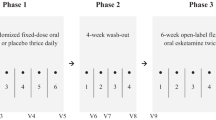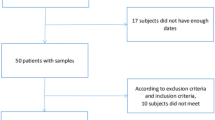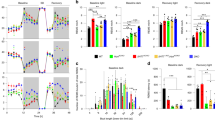Abstract
The effects on cataplexy and daytime sleep of acute and chronic oral administration of CG-3703, a potent TRH analog were assessed in canine narcolepsy. CG-3703 was found to be orally active and to reduce cataplexy (0.25 to 16 mg/kg) and sleep (8 and 16 mg/kg) in a dose-dependent manner. Two-week oral administration of CG-3703 (16 mg/kg) significantly reduced cataplexy and daytime sleep. The anticataplectic effects of CG-3703 were not associated with changes in general behavior, heart rate, blood pressure, rectal temperature, blood chemistry and thyroid function. Although drug tolerance for the effects on cataplexy and sleep were observed during the second week of chronic drug administration, therapeutic efficacy on cataplexy was improved with individual dose adjustment (final dose range: 16 to 28 mg/kg, p.o.). These results suggest that TRH analogs could be a promising new form of treatment for human narcolepsy.
Similar content being viewed by others
Log in or create a free account to read this content
Gain free access to this article, as well as selected content from this journal and more on nature.com
or
References
Aldrich MS . (1992): Narcolepsy. Neurology 42: 34–43
Ang ES, Teh HS, Sundram FX, Lee KO . (1995): Effect of lithium and oral thyrotrophin-releasing hormone (TRH) on serum thyrotrophin (TSH) and radioiodine uptake in patients with well differentiated thyroid carcinoma. Singapore Med J 36: 606–608
Baker TL, Dement WC . (1985): Canine narcolepsy-cataplexy syndrome: evidence for an inherited monoaminergic-cholinergic imbalance. In McGinty DJ, Drucker-Colin R, Morrison A, Parmeggiani PL (eds), Brain Mechanisms of Sleep. New York, Raven Press, pp 199–233
Boler J, Enzmann F, Folkers K, Bowers CY, Schally AV . (1969): The identity of chemical and hormonal properties of the thyrotropin releasing hormone and pyroglutamyl-histidyl-proline-amide. Biochem Biophys Res Commun 37: 705–710
Cirelli C, Pompeiano M, Tononi G . (1996): Neuronal gene expression in the waking state: a role for the locus coeruleus. Science 274: 1211–1215
Engel WK, Siddique T, Nicoloff J . (1983): Effect on weakness and spasticity in amyotrophic lateral sclerosis of thyrotropin-releasing hormone. Lancet 2: 73–75
Flohé L, Bauer K, Friderichs E, Gunzler W, Hennies H, Herrling S, Lagler F, Otting F, Schwertner E . (1983): Biological effects of degradation-stabilized TRH analogues. In Griffiths E, Bennett G (eds), Thyrotropin-releasing hormone. New York, Raven Press, pp 327–340
Griffiths EC, Bennett GW . (1987): Clinical applications of thyrotropin-releasing hormone. Clin Sci 73: 449–457
Guilleminault C . (1994): Narcolepsy Syndrome. In Kryger MH, Roth T, Dement WC (eds), Principles and Practice of Sleep Medicine, ed. Philadelphia, W. B. Saunders Company, pp 549–561
Heal DJ, Stoodley N, Elliott JM, Marsden CA, Bennet GW, Youdim MBH . (1987): Behavioural and biochemical evidence for the release of noradrenaline in mouse brain by TRH and some of its biologically stable analogues. Neuropharmacology 26: 313–322
Horst WD, Spirt N . (1974): A possible mechanism for the anti-depressant activity of thyrotropin-releasing hormone. Life Sciences 15 (6): 1073–1082
Jackson IMD . (1982): Thyrotropin-releasing hormone. N Engl J Med 306: 145–155
Kaitin KI, Kilduff TS, Dement WC . (1986): Sleep fragmentation in genetically narcoleptic dogs. Sleep 9: 116–119
Kanbayashi T, Honda K, Kodama T, Mignot E, Nishino S . (1998): Increased dopaminergic transmission mediates wake-promoting effects of amphetamine isomers. Soc Neurosci Abstract 23: 954
Kolesnick RN, Gershengorn MC . (1985): Thyrotropin-releasing hormone and the pituitary: new insights into the mechanisms of stimulated secretion and clinical usage. Am J Med 79: 729–739
Kreider MS, Engber TM, Nilaver G, Zimmerman EA, Winokur A . (1985): Immunohistochemical localization of TRH in rat CNS: comparison with RIA studies. Peptides 6: 997–1000
Lin L, Faraco J, Li R, Kadotani H, Rogers W, Lin X, Qiu X, de Jong P, Nishino S, Mignot E . (1999): The sleep disorder canine narcolepsy is caused by a mutation in the hypocretin (orexin) receptor 2 gene. Cell 98: 365–376
Metcalf G . (1982): Regulatory peptides as a source of new drugs: the clinical prospects for analogs of TRH which are resistant to metabolic degradation. Brain Res Rev 4: 389–408
Mignot E, Guilleminault C, Bowersox S, Rappaport A, Dement WC . (1988): Role of central alpha-1 adrenoceptors in canine narcolepsy. J Clin Invest 82: 885–894
Mignot E, Renaud A, Nishino S, Arrigoni J, Guilleminault C, Dement WC . (1993): Canine cataplexy is preferentially controlled by adrenergic mechanisms: evidence using monoamine selective uptake inhibitors and release enhancers. Psychopharmacology 113: 76–82
Mitler MM, Hajdukovic R, Erman M, Koziol JA . (1990): Narcolepsy. J Clin Neurophysiol 7: 93–118
Miyamoto T, Ishihara K, Kimura K, Naoyuki T, Fujita Y, Serikawa T, Sasa M . (1996): Long-term antiepileptic effects of chronic intake of CNK-602A, a thyrotropin-releasing hormone analogue on spontaneously-epileptic rats. Epilepsia 37: 328–331
Momiyama T, Ishihara K, Kimura K, Naoyuki T, Fujita Y, Serikawa T, Sasa M . (1996): Long-term antiepileptic effects of chronic intake of CNK-602A, a thyrotropin-releasing hormone analogue on spontaneously-epileptic rats. Epilepsia 37: 328–331
Nishino S, Arrigoni J, Fruhstorfer B, Shelton J, Dement WC, Mignot E . (1992): Effects of chronic administration of yohimbine (alpha-2 antagonist) on cataplexy and platelet alpha-2 receptors of narcoleptic canines. Sleep Research 21: 66
Nishino S, Arrigoni J, Shelton J, Dement WC, Mignot E . (1993): Desmethyl metabolites of serotonergic uptake inhibitors are more potent for suppressing canine cataplexy than their parent compounds. Sleep 16: 706–712
Nishino S, Arrigoni J, Shelton J, Kanbayashi T, Tafti A, Dement WC, Mignot E . (1997): Effects of thyrotropin-releasing hormone and its analogs on daytime sleepiness and cataplexy in canine narcolepsy. J Neurosci 17: 6401–6408
Nishino S, Honda K, Riehl J, Mignot E . (1998a): Extracellular single unit recordings of dopaminergic output neurons in the nucleus accumbens and globus pallidus in narcoleptic Dobermans. J Sleep Res 7: S2: 187
Nishino S, Mao J, Sampathkumaran R, Shelton J, Mignot E . (1998b): Increased dopaminergic transmission mediates the wake-promoting effects of CNS stimulants. Sleep Research Online 1: 49–61. http://www.sro.org/1998/Nishino/49/
Nishino S, Mignot E . (1997): Pharmacological aspects of human and canine narcolepsy. Prog Neurobiol 52: 27–78
Nishino S, Reid MS, Dement WC, Mignot E . (1994): Neuropharmacology and neurochemistry of canine narcolepsy. Sleep 17: S84–92
Nishino S, Riehl J, Hong J, Kwan M, Honda K, Dement W, Mignot E . (1998c): REM sleep cyclicity is intact in narcoleptic canines. Soc Neurosci Abstract 23: 938
Nishino S, Tafti M, Reid MS, Shelton J, Siegel JM, Dement WC, Mignot E . (1995): Muscle atonia is triggered by cholinergic stimulation of the basal forebrain: implication for the pathophysiology of canine narcolepsy. J Neurosci 15: 4806–4814
Peyron C, Tighe DK, van den Pol AN, de Lecea L, Heller HC, Sutcliffe JG, Kilduff TS . (1998): Neurons containing hypocretin (orexin) project to multiple neuronal systems. J Neurosc 18: 9996–10015
Pijnenburg AJ, Honig WM, Van der Heyden JA, Van Rossum JM . (1976): Effects of chemical stimulation of the mesolimbic dopamine system upon locomotor activity. Eur J Pharmacology 35: 45–58
Prange A, Wilson I, Lara P, Alltop L, Breese G . (1972): Effects of thyrotropin-releasing hormone in depression. Lancet 2: 999–1002
Riehl J, Nishino S, Cederberg R, Dement WC, Mignot E . (1998): Development of cataplexy in genetically narcoleptic Dobermans. Exp Neurol 152: 292–302
Sakurai T, Amemiya A, Ishii M, Matsuzaki I, Chemelli RM, Tanaka H, Williams SC, Richardson JA, Kozlowsky GP, Wilson S, Arch JRS, Buckingham RE, Haynes AC, Carr SA, Annan RS, McNulty DE, Liu W, Terrett JA, Eishourbagy NA, Bergsma DJ, Yanagisawa M . (1998): Orexins and orexin receptors: A family of G protein-coupled receptors that regulate feeding behavior. Cell 92: 573–585
Sharif N . (1985): Diverse roles of thyrotropin-releasing hormone in brain, pituitary and spinal cord function. Trends Pharmacol Sci 6: 119–122
Shelton J, Nishino S, Vaught J, Dement WC, Mignot E . (1995): Comparative effects of modafinil and amphetamine on daytime sleepiness and cataplexy of narcoleptic dogs. Sleep 18: 817–826
Sobue I, Takayanagi T, Nakanishi T, Tsubaki T, Uono M, Kinoshita M, Igata A, Miyazaki M, Yoshida M, Ando K, Maruyama S, Mitsuma T, Nihei N, Sakuma A, Kato K . (1983): Controlled trial of thyrotropin releasing hormone tartrate in ataxia of spinocerebellar degenerations. J Neuro Sci 61: 235–248
Thorpy MJ, Goswami M . (1990): Treatment of narcolepsy. In Thorpy MJ (ed), Handbook of Sleep Disorders, ed. New York, Marcel Dekker, Inc., pp 235–258
Tuomisto J, Männistö P . (1973): Amine uptake and thyrotropin-releasing hormone. Lancet 836
Winokur A, Manaker S, Kreider M . (1989): TRH and TRH receptors in the spinal cord. Ann New York Acad Sci 553: 314–324
Acknowledgements
The authors would like to thank J. Shelton, S. von Richthofen, and the staff of the Department of Comparative Medicine for technical assistance. This work was supported by NS 27710, NS23724 and MH01600.
Author information
Authors and Affiliations
Rights and permissions
About this article
Cite this article
Riehl, J., Honda, K., Kwan, M. et al. Chronic Oral Administration of CG-3703, a Thyrotropin Releasing Hormone Analog, Increases Wake and Decreases Cataplexy in Canine Narcolepsy. Neuropsychopharmacol 23, 34–45 (2000). https://doi.org/10.1016/S0893-133X(99)00159-1
Received:
Revised:
Accepted:
Issue date:
DOI: https://doi.org/10.1016/S0893-133X(99)00159-1
Keywords
This article is cited by
-
Analysis of thyroid function and related factors in narcolepsy patients
Scientific Reports (2023)



